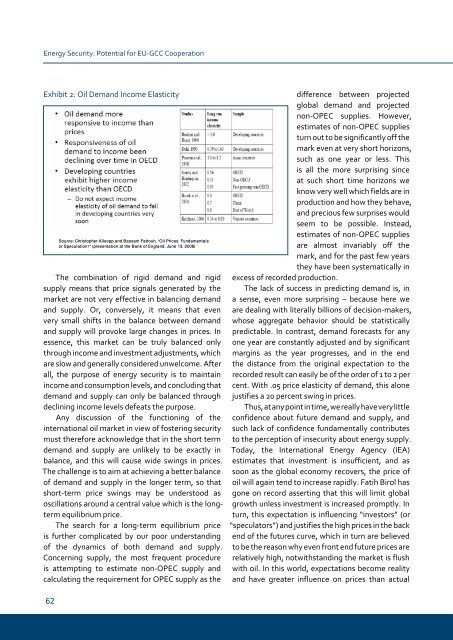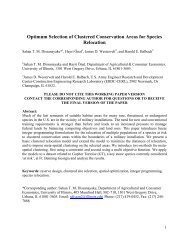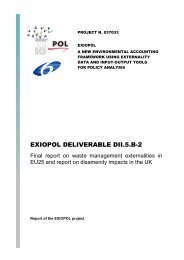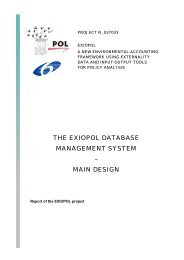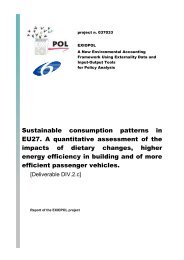Gulf and European Energy Supply Security - Feem-project.net
Gulf and European Energy Supply Security - Feem-project.net
Gulf and European Energy Supply Security - Feem-project.net
Create successful ePaper yourself
Turn your PDF publications into a flip-book with our unique Google optimized e-Paper software.
<strong>Energy</strong> <strong>Security</strong>: Potential for EU-GCC Cooperation<br />
2<br />
Source: Christopher Allsopp <strong>and</strong> Bassam Fattouh, “Oil Prices: Fundamentals<br />
or Speculation?” (presentation at the Bank of Engl<strong>and</strong>, June 13, 2008)<br />
Exhibit 2: Oil Dem<strong>and</strong> Income Elasticity<br />
Source: Christopher Allsopp <strong>and</strong> Bassam Fattouh, “Oil Prices: Fundamentals<br />
or Speculation?” (presentation at the Bank of Engl<strong>and</strong>, June 13, 2008)<br />
The combination of rigid dem<strong>and</strong> <strong>and</strong> rigid<br />
supply means that price signals generated by the<br />
market are not very effective in balancing dem<strong>and</strong><br />
<strong>and</strong> supply. Or, conversely, it means that even<br />
very small shifts in the balance between dem<strong>and</strong><br />
<strong>and</strong> supply will provoke large changes in prices. In<br />
essence, this market can be truly balanced only<br />
through income <strong>and</strong> investment adjustments, which<br />
are slow <strong>and</strong> generally considered unwelcome. After<br />
all, the purpose of energy security is to maintain<br />
income <strong>and</strong> consumption levels, <strong>and</strong> concluding that<br />
dem<strong>and</strong> <strong>and</strong> supply can only be balanced through<br />
declining income levels defeats the purpose.<br />
Any discussion of the functioning of the<br />
international oil market in view of fostering security<br />
must therefore acknowledge that in the short term<br />
dem<strong>and</strong> <strong>and</strong> supply are unlikely to be exactly in<br />
balance, <strong>and</strong> this will cause wide swings in prices.<br />
The challenge is to aim at achieving a better balance<br />
of dem<strong>and</strong> <strong>and</strong> supply in the longer term, so that<br />
short-term price swings may be understood as<br />
oscillations around a central value which is the longterm<br />
equilibrium price.<br />
The search for a long-term equilibrium price<br />
is further complicated by our poor underst<strong>and</strong>ing<br />
of the dynamics of both dem<strong>and</strong> <strong>and</strong> supply.<br />
Concerning supply, the most frequent procedure<br />
is attempting to estimate non-OPEC supply <strong>and</strong><br />
calculating the requirement for OPEC supply as the<br />
difference between <strong>project</strong>ed<br />
global dem<strong>and</strong> <strong>and</strong> <strong>project</strong>ed<br />
non-OPEC supplies. However,<br />
estimates of non-OPEC supplies<br />
turn out to be significantly off the<br />
mark even at very short horizons,<br />
such as one year or less. This<br />
is all the more surprising since<br />
at such short time horizons we<br />
know very well which fields are in<br />
production <strong>and</strong> how they behave,<br />
<strong>and</strong> precious few surprises would<br />
seem to be possible. Instead,<br />
estimates of non-OPEC supplies<br />
are almost invariably off the<br />
mark, <strong>and</strong> for the past few years<br />
they have been systematically in<br />
excess of recorded production.<br />
The lack of success in predicting dem<strong>and</strong> is, in<br />
a sense, even more surprising – because here we<br />
are dealing with literally billions of decision-makers,<br />
whose aggregate behavior should be statistically<br />
predictable. In contrast, dem<strong>and</strong> forecasts for any<br />
one year are constantly adjusted <strong>and</strong> by significant<br />
margins as the year progresses, <strong>and</strong> in the end<br />
the distance from the original expectation to the<br />
recorded result can easily be of the order of 1 to 2 per<br />
cent. With .05 price elasticity of dem<strong>and</strong>, this alone<br />
justifies a 20 percent swing in prices.<br />
Thus, at any point in time, we really have very little<br />
confidence about future dem<strong>and</strong> <strong>and</strong> supply, <strong>and</strong><br />
such lack of confidence fundamentally contributes<br />
to the perception of insecurity about energy supply.<br />
Today, the International <strong>Energy</strong> Agency (IEA)<br />
estimates that investment is insufficient, <strong>and</strong> as<br />
soon as the global economy recovers, the price of<br />
oil will again tend to increase rapidly. Fatih Birol has<br />
gone on record asserting that this will limit global<br />
growth unless investment is increased promptly. In<br />
turn, this expectation is influencing “investors” (or<br />
“speculators”) <strong>and</strong> justifies the high prices in the back<br />
end of the futures curve, which in turn are believed<br />
to be the reason why even front end future prices are<br />
relatively high, notwithst<strong>and</strong>ing the market is flush<br />
with oil. In this world, expectations become reality<br />
<strong>and</strong> have greater influence on prices than actual


